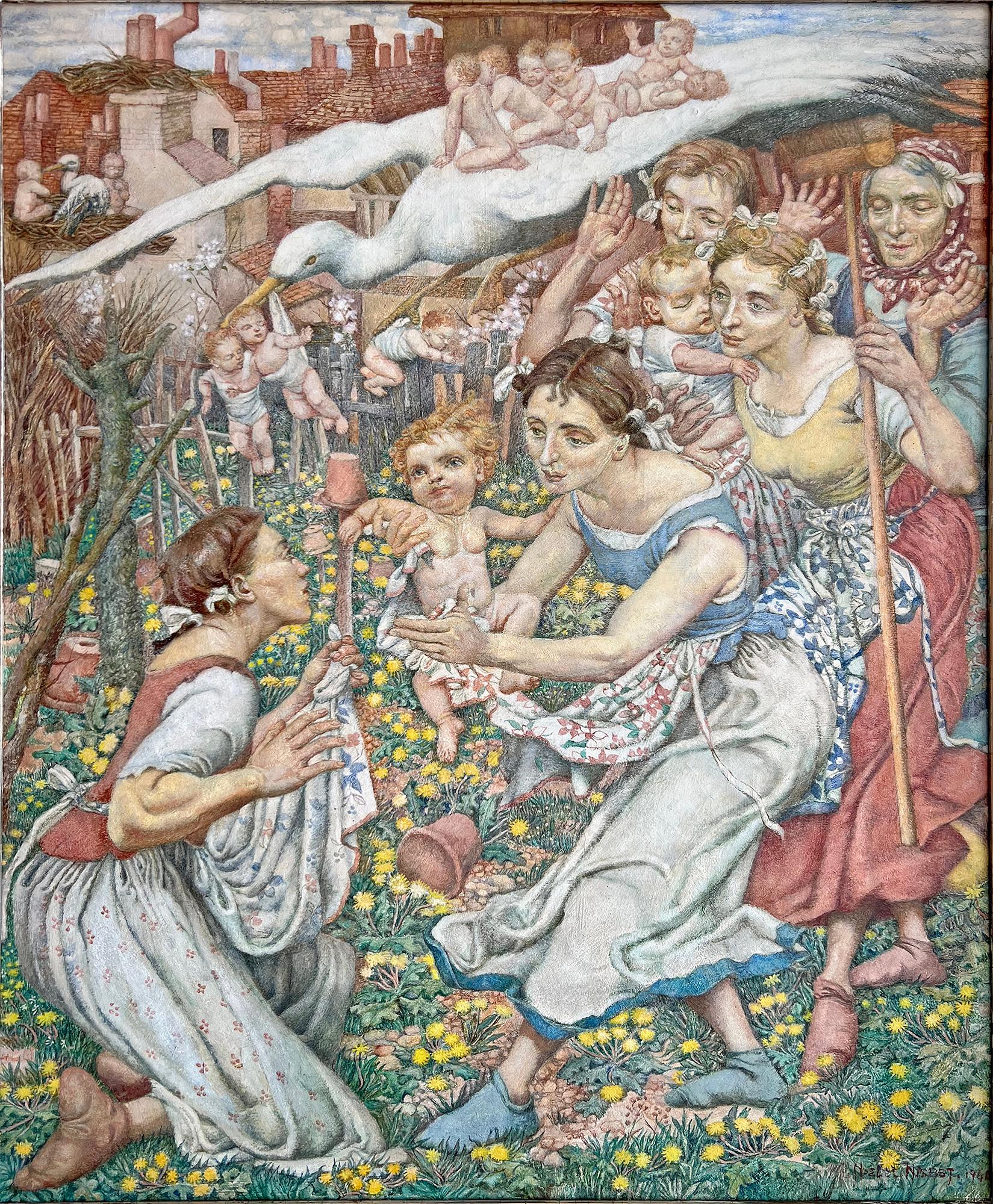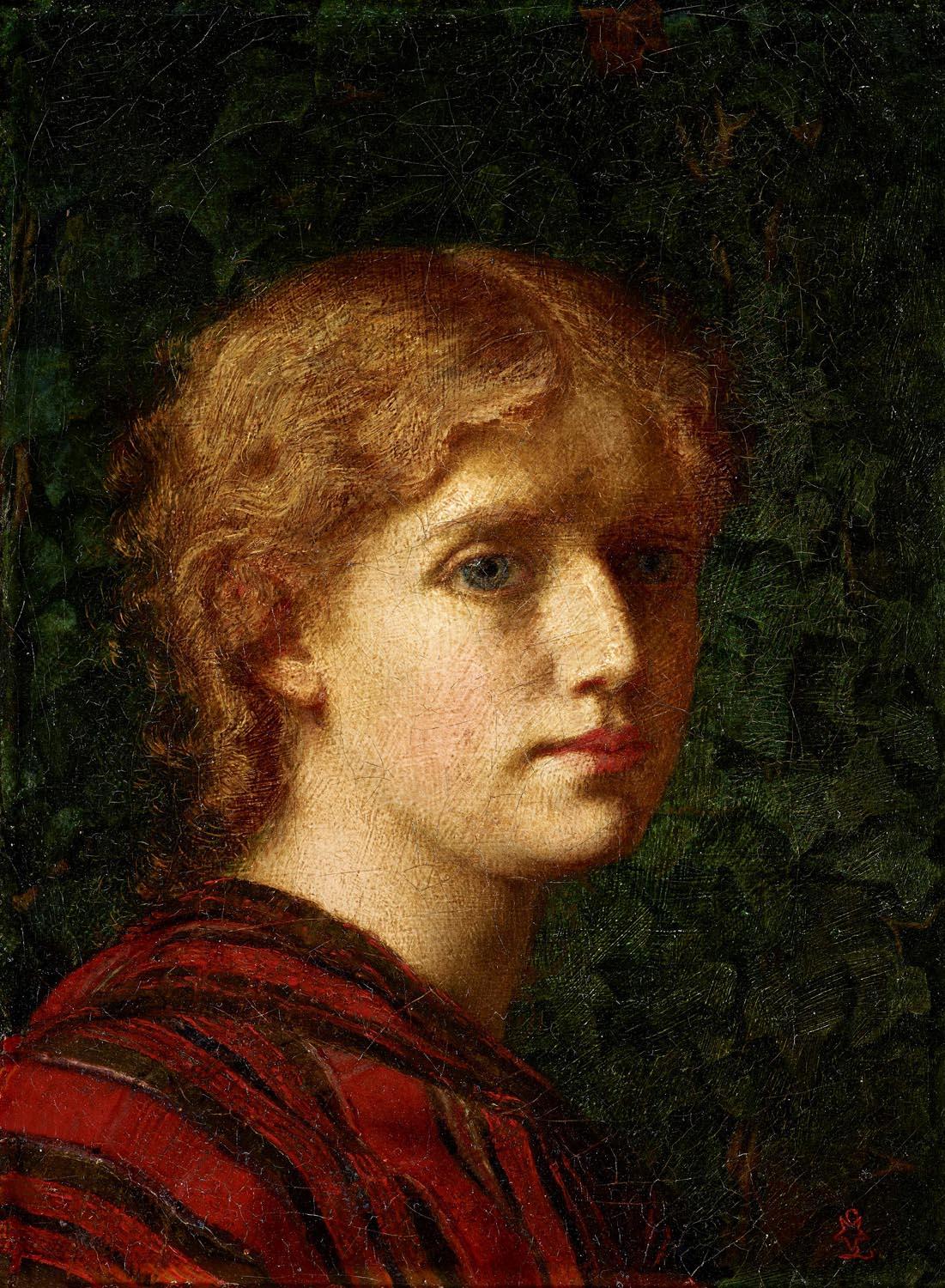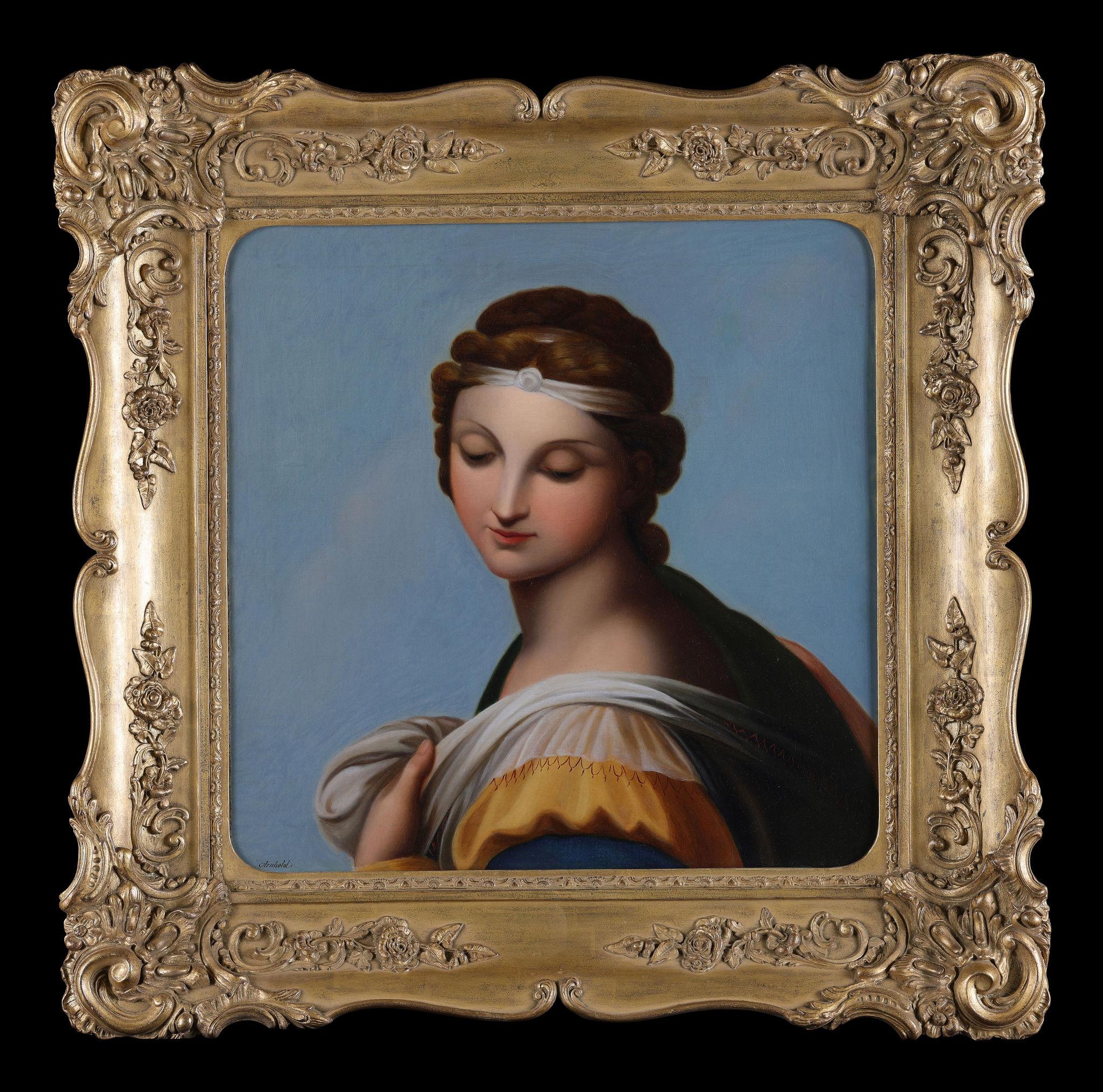Items Similar to Portrait of a Girl Holding Wool - British Edwardian female portrait oil painting
Want more images or videos?
Request additional images or videos from the seller
1 of 15
Maud Marion WearPortrait of a Girl Holding Wool - British Edwardian female portrait oil paintingCirca 1905
Circa 1905
About the Item
This beautiful British Edwardian portrait oil painting is by noted and much exhibited female artist Maud Marion Wear. Wear trained at the Royal Academy Schools in London for five years and then went on to combine teaching art and exhibiting for over forty years including 45 works at the Royal Academy. Her painting were mainly portraits and figure studies. This lovey painting, painted circa 1905 is a three quarter length portrait of a young woman in front of a leaded window. She is wearing a dark dress with lace collar and lace cap. In her hands she holds a ball of tangerine wool. These colours are beautifully echoed by the autumnal trees behind her through the window. She is gazing down to her right. This painting is absolutely exquisite in its colouring with the vivid orange and greens behind her and her rosy cheeks and red lips. The sympathetic soft focus detail in her face is also superb. This is a fantastic example of Wear's work as a female artist and is just a pleasure to behold.
Indistinctly signed lower right.
Signed 'Maud M Wear' on stretcher verso.
Provenance. Essex estate.
Condition. Oil on canvas, 36 inches by 22 inches unframed, in good condition.
Frame. Housed in a gilt oak frame 43 inches by 29 inches and in good condition.
Maud Marian Wear (1873-1955) was a British artist, known as a painter and miniaturist. Wear was born in London to a local women and a wine merchant's clerk from Yorkshire, who later became a newspaper correspondent. Wear was raised in Hackney and privately educated at Eastbourne before entering the Royal Academy Schools in 1896-1901. During her five years at the Academy Schools, Wear won a silver medal for a painting of the draped figure. Subsequently, she combined teaching at the London County Council Central School of Arts and Crafts with an exhibition career that was noted for its portraits and figure studies. Wear exhibited between 1900-1940 and showed a total of 45 works at the Royal Academy in London and also exhibited with the New English Art Club, the International Society of Sculptors, Painters and Gravers, the Royal Miniature Society and at the Glasgow Art Gallery, the Walker Art Gallery in Liverpool and the Paris Salon. For a time, Wear lived at Blockley in Gloucestershire but moved between several locations in southern England during her life and died at Hove in East Sussex.
- Creator:Maud Marion Wear (1837 - 1955, British)
- Creation Year:Circa 1905
- Dimensions:Height: 43 in (109.22 cm)Width: 29 in (73.66 cm)Depth: 2 in (5.08 cm)
- Medium:
- Movement & Style:
- Period:
- Condition:
- Gallery Location:London, GB
- Reference Number:1stDibs: LU853113069742
About the Seller
5.0
Platinum Seller
These expertly vetted sellers are 1stDibs' most experienced sellers and are rated highest by our customers.
1stDibs seller since 2018
398 sales on 1stDibs
Typical response time: <1 hour
- ShippingRetrieving quote...Ships From: London, United Kingdom
- Return PolicyA return for this item may be initiated within 14 days of delivery.
More From This SellerView All
- Portrait of a Young Girl in a White Dress - British Edwardian art oil paintingBy Robert Edward MorrisonLocated in London, GBThis lovely British Edwardian portrait oil painting is by noted Liverpool artist Robert Edward Morrison. Born on the Isle of Man, Morrison moved to Liv...Category
Early 1900s Pre-Raphaelite Portrait Paintings
MaterialsOil
- Charity - Royal Academy exhib. 19thC art Pre-Raphaelite portrait oil paintingBy Rudolf LehmannLocated in London, GBThis stunning circular 19th century oil painting is by noted prolific Royal Academy exhibited artist Rudolf Lehmann. A portrait artist, German born Lehmann moved to England in 1866 w...Category
19th Century Pre-Raphaelite Portrait Paintings
MaterialsOil
- Portrait of a Young Woman - Pre-Raphaelite Victorian drawing girl white collarLocated in London, GBThis beautiful Victorian pencil drawing dates to around 1890 and is by an unknown hand. It is a head and shoulders portrait of a young lady gazing to her right. Her dark hair is tied...Category
19th Century Pre-Raphaelite Portrait Paintings
MaterialsCharcoal, Pencil
- Portrait of a Boy with Bird - British 17th century art Old Master oil paintingLocated in London, GBThis stunning 17th century Old Master portrait oil painting is attributed to Godfrey Kneller. Painted circa 1680 it is a superb full length portrait of a blonde haired boy holding a struggling bird. He is bare foot and dressed in a white shirt with gold shawl around him. In the background is a blue drape. There is lovely detail and brushwork in his facial features and vibrant colouring. This a superb 17th century Old Master oil painting housed in a lovely frame. Provenance. Two ascribed labels verso Christie's stamp verso. . Condition. Oil on canvas in good condition, 36 inches by 28 inches approx. Frame. Housed in an ornate frame, 43 inches by 35 inches approx. Sir Godfrey Kneller, 1st Baronet (born Gottfried Kniller; 8 August 1646 – 19 October 1723), was the leading portrait painter in England during the late 17th and early 18th centuries, and was court painter to English and British monarchs from Charles II to George I. Kneller was born Gottfried Kniller in the Free City of Lübeck, the son of Zacharias Kniller, a portrait painter. Kneller studied in Leiden, but became a pupil of Ferdinand Bol and Rembrandt Harmenszoon van Rijn in Amsterdam. He then travelled with his brother John Zacharias Kneller, who was an ornamental painter, to Rome and Venice in the early 1670s, painting historical subjects and portraits in the studio of Carlo Maratti, and later moved to Hamburg. The brothers came to England in 1676, and won the patronage of the Duke of Monmouth. He was introduced to, and painted a portrait of, Charles II. In England, Kneller concentrated almost entirely on portraiture. In the spirit of enterprise, he founded a studio which churned out portraits on an almost industrial scale, relying on a brief sketch of the face with details added to a formulaic model, aided by the fashion for gentlemen to wear full wigs. His portraits set a pattern that was followed until William Hogarth and Joshua Reynolds. Nevertheless, he established himself as a leading portrait artist in England. When Sir Peter Lely died in 1680, Kneller was appointed Principal Painter in Ordinary to the Crown by Charles II. For about 20 years (c.1682-1702) he lived at No. 16-17 The Great Piazza, Covent Garden. In the 1690s, Kneller painted the Hampton Court Beauties depicting the most glamorous ladies-in-waiting of the Royal Court for which he received his knighthood from William III. He produced a series of "Kit-cat" portraits of 48 leading politicians and men of letters, members of the Kit-Cat Club. Created a baronet by King George I on 24 May 1715, he was also head of the Kneller Academy of Painting and Drawing 1711–1716 in Great Queen Street, London, which counted such artists as Thomas Gibson amongst its founding directors. His paintings were praised by Whig members including John Dryden, Joseph Addison, Richard Steele, and Alexander Pope. On the landing in Horsham Museum hang works of art from the Museum's extensive painting collection, featuring a large 18th-century portrait of Charles Eversfield and his wife, of Denne Park House. In the painting Eversfield is giving his wife some violets which signifies fidelity, love and honesty. It is likely that the picture was cut down at some time as it was unusual to stop just below the knee. It may have been painted by more than one person: someone who specialised in clothing, another in drapes, and so on, with perhaps Kneller painting the heads, for it was the portraits that gave the sitters their identity, everything else is rather formulaic. He married a widow, Susanna Grave, on 23 January 1704 at St Bride...Category
1680s Old Masters Portrait Paintings
MaterialsOil
- Race Horse Phoenix with Guilermo Kemmis - British 19th century art oil paintingLocated in London, GBThis superb British 19th century equine oil painting is by noted horse lover, George Gascoyne. Painted in 1889, this French born chestnut horse is Phoenix. While he was essentially a...Category
1880s Realist Animal Paintings
MaterialsOil
- Exotic - Scottish 1920's exhibited 'Glasgow Girl' art portrait oil paintingLocated in London, GBThis stunning much exhibited 1920's Scottish portrait oil painting is by noted Glasgow Girl artist Norah Nielson Gray. Painted circa 1923, the model for the painting was Rita McIlraith but the artist did not want to use her name in the title and it was called 'Exotic.' Norah Neilson Gray...Category
1920s Art Deco Portrait Paintings
MaterialsOil
You May Also Like
- Pre-Raphaelite Style Painting of Mothers and Babies in WWIILocated in Miami, FLBabies are falling from the sky and not bombs. British female artist and illustrator Noel Laura Nisbet makes a passionate twist to the reality of En...Category
1940s Pre-Raphaelite Figurative Paintings
MaterialsCanvas, Tempera, Mixed Media, Oil
- Guinevere - 19th Century Pre-Raphaelite Oil Painting of Arthururian Queen LegendLocated in Gerrards Cross, GB‘Guinevere’ by Norman Prescott-Davies R.B.A, R.C.A. (1861-1915). The painting – which depicts an English mediaeval portrait of Queen Guinevere at Amesbury Priory contemplating her lo...Category
Late 19th Century Pre-Raphaelite Portrait Paintings
MaterialsOil
- Portrait of a Young Woman, 19th Century Pre-Raphaelite Oil on CanvasLocated in London, GBLouisa Starr 1845 - 1909 Portrait of a Young Woman Oil on canvas, monogrammed Image size: 8 ½ x 6 ¼ inches (22 x 16 cm) Pre-Raphaelite style frame Provenance Family Estate Christies Private Estate This rare beautiful portrait is clearly influenced by the Pre-Raphaelites, who were friends of Louisa Starr. The Pre-Raphaelites often included symbolic elements in their work, and the background of ivy in this painting, symbolising everlasting life, is a reference to that. This is an early work by Starr as she uses her monogram of a letter L with a star, which can be seen bottom right. The photograph below shows the painting in her studio, top left. The Artist Louisa Starr was born in Liverpool of American descent. Starr attended Heatherley's Art School. During this period artistic training was dominated by the Royal Academy Schools, which gave students a rigorous grounding in life-drawing and painting, presided over by Frederick Leighton and staffed by some of the leading artists of the time. Competition to enter the RA schools was very great, and at sixteen Louisa Starr became the youngest student ever to attend, being one of two students selected out of thirty eight entrants. The fact that she was a woman is very significant. She signed her work 'L Starr' so that her gender was not apparent, and when her identity became known, she was told that it was not permitted by the constitution to admit female students. (Women had attended the RA Schools before but not in any great number and not for some time). When she asked to see the clause, it could not be found, and they ended up admitting six women students so that they could chaperone each other. She had an outstanding career as a student, winning a Silver medal for the best copy of Murillo's 'Beggars' in 1865 - which was the first medal ever awarded by the RA to a woman, and a Gold medal for the most successful historical painting in 1867. She met her future husband, Enrico Canziani, an Italian cousin, whilst visiting relatives in Italy. Her independent outlook and progressive thinking were somewhat at odds with traditional Italian village life, but Enrico understood and encouraged her work by setting up a studio space and helping to find local models for her to paint. He was a civil engineer, who had built a sugar refinery in Italy and established paper-mills and chemical product factories. They married in Dover in 1882, when Starr was thirty seven, and her attitude to life and work continued to be assertive and uncompromising. For example, she removed the 'obey' from the marriage service, and it was decided that she would continue to live and work in England, and Enrico would be the one to move. He settled in England, but as much of his business was in Italy he continued to visit at least three times a year. Their daughter Estella was born in 1887. She became a portrait and landscape painter, an interior decorator and a travel writer and folklorist. Estella reports that her mother dreamed of an ideal house and recognised it while driving in Kensington Gardens, seeing a board up advertising it to let. She telegraphed to her husband to come back from Paris and they secured the property just five minutes ahead of a gentleman who was also waiting for the office to open. Estella was born there two years later. The address was 3 Palace Green, Kensington. Louisa was good friends with many of the prominent artists of the day including Frederick Lord Leighton, Val Princep and his family who lived next door to Leighton as well as G F Watts...Category
1850s Pre-Raphaelite Portrait Paintings
MaterialsOil
- Guinevere - 19th Century Pre-Raphaelite Oil Painting of King Arthur Queen LegendLocated in Gerrards Cross, GB‘Guinevere’ by Norman Prescott-Davies R.B.A, R.C.A. (1861-1915). The painting – which depicts an English mediaeval portrait of Queen Guinevere at Amesbury Priory contemplating her lo...Category
Late 19th Century Pre-Raphaelite Portrait Paintings
MaterialsOil
- ANTIQUE Pre-Raphaelite Portrait Affluent Woman Stained Glass WindowsBy Charles Frederick LowcockLocated in New York, NYUp for sale is this detailed and tentative portrait of an elegant woman in a common room or 'parlor'. By a famous English Pre-Raphaelite artist. Barked Frederick Lowcock. The woman can be seen standing before beautifully decorated interior. Some of the focuses in this painting is the stained glass window, a tall marble statue of a woman, exotic palm leaves and plants, paintings, easels, and antique furniture, a . By placing the objects in their proper places, Lowcock gave the observer a better understanding of who was being depicted in his portraits. The Royal Academy (1878–1904), Suffolk Street (1880–1892), and Thomas McLean's gallery (1892) all hosted Lowcock exhibitions. A number of biographical dictionaries, notably Benezit and Wood's Dictionary of Victorian Painters, which features an image of his work, mention Lowcock as an artist. The abbreviation CF Lowcock RBA, which stands for Royal Society of British Artists, is sometimes used to refer to Charles Frederick Lowcock. Pre-Raphaelite Woman in Study Sight size 10x18.5 inches With frame 20x29 inches Oil on Panel With Gilded Frame Signed lower left Lechertier...Category
Late 19th Century Pre-Raphaelite Portrait Paintings
MaterialsOil
- A Pre-Raphaelite BeautyLocated in St. Albans, GBA wonderful painting of a beautiful woman in the style of the Pre-Raphaelites. It is signed Arnhold. It is in very condition and in the original frame. Picture Size: 21 x 21" (51 ...Category
1850s Pre-Raphaelite Portrait Paintings
MaterialsOil



